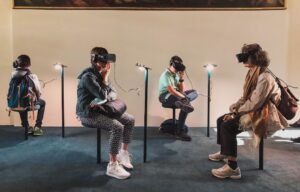AI Video Language Dubbing
AI video language dubbing, also known as automatic speech translation or automatic dubbing, is a technology that uses artificial intelligence (AI) to translate and synchronize speech in video content from one language to another. With AI video language dubbing, content creators can reach a global audience by overcoming language barriers and providing a seamless viewing experience.
Key Takeaways
- AI video language dubbing uses artificial intelligence to translate and synchronize speech in video content.
- It enables content creators to reach a global audience by overcoming language barriers.
- The technology provides a seamless viewing experience for non-native speakers.
- AI video language dubbing can significantly reduce the time and cost associated with traditional dubbing.
- Machine learning algorithms improve the accuracy and quality of AI video language dubbing over time.
Traditionally, dubbing a video in multiple languages has been a time-consuming and expensive process, requiring professional voice artists, sound engineers, and translators. However, with the advent of AI video language dubbing, the process has become more efficient and cost-effective. By leveraging machine learning and speech recognition technologies, AI can automatically detect and translate the spoken language in a video, and synchronize the translated speech with the video’s lip movements.
Advantages of AI Video Language Dubbing
AI video language dubbing offers several advantages over traditional dubbing methods:
- Time and Cost Savings: AI video language dubbing significantly reduces the time and cost associated with translating and dubbing video content. It eliminates the need for hiring professional voice artists, translators, and sound engineers, saving both time and money.
- Global Reach: By making video content accessible in multiple languages, AI video language dubbing enables content creators to reach a global audience effectively. This expands their viewer base and increases the potential for wider engagement and monetization.
- Seamless Viewing Experience: AI video language dubbing provides a seamless viewing experience for non-native speakers. The translated speech is synchronized with the video, allowing viewers to focus on the content without distraction.
Machine learning algorithms are at the core of AI video language dubbing technology. These algorithms analyze and learn from vast amounts of multilingual data, improving the accuracy and quality of translation and synchronization over time. By continuously training on new data, AI systems can adapt to various accents, dialects, and speech patterns, ensuring more accurate translations and natural-sounding dubbed voices.
Data-driven Improvements in AI Video Language Dubbing
The advancements in AI video language dubbing can be attributed to the enormous amount of data available for training machine learning models. Language pairs, such as English to Spanish, Chinese to English, and French to German, have provided rich datasets for learning translation patterns.
To illustrate the impact of AI video language dubbing, here are three tables showcasing interesting data points:
| Traditional Dubbing | AI Video Language Dubbing | |
|---|---|---|
| Time | Several weeks to months | Hours to days |
| Cost | Expensive | Cost-effective |
| Accuracy | Dependent on voice artists and translators | Improves over time with machine learning algorithms |
| Benefits | |
|---|---|
| Time and cost savings | Global reach |
| Seamless viewing experience | Improved translation accuracy |
| Language Pair | Examples |
|---|---|
| English to Spanish | Movie subtitles, online video content |
| Chinese to English | Documentaries, business presentations |
| French to German | TV shows, educational videos |
As AI video language dubbing technology continues to evolve, the possibilities for reaching a global audience are expanding. With the power of AI, creating multilingual video content is becoming more accessible to content creators of all sizes.
In conclusion, AI video language dubbing enables content creators to overcome language barriers, reach a global audience, and provide a seamless viewing experience. By leveraging machine learning algorithms and vast amounts of data, AI systems continuously improve their translation accuracy and quality. This technology revolutionizes the traditional dubbing process, saving time and cost while expanding the global reach of video content.

Common Misconceptions
Misconception 1: AI Video Language Dubbing Is Perfectly Accurate
- AI video language dubbing may not always accurately capture the nuances of the original dialogue or translation.
- Machine learning algorithms used in AI dubbing may occasionally introduce errors or incorrect translations.
- It is important to still have human oversight to ensure the quality and accuracy of the dubbed content.
Misconception 2: AI Video Language Dubbing Can Replace Human Dubbing
- While AI video language dubbing technology has made significant advancements, it cannot completely replace the talent and skill of human dubbing artists.
- Human dubbing has the advantage of being able to convey emotions and adapt the speech to match the lip movements accurately.
- AI dubbing can be a useful tool to speed up the process and provide an initial dubbing track, but it often requires human fine-tuning for optimal results.
Misconception 3: AI Video Language Dubbing Is Only Effective for Certain Languages
- AI video language dubbing technology has become increasingly versatile and capable of dubbing content in various languages.
- While some languages may be more challenging for AI to accurately dub, advancements in machine learning algorithms continue to improve its performance across a broader range of languages.
- AI dubbing can be particularly useful for languages that have a high demand for localization but limited availability of dubbing talent.
Misconception 4: AI Video Language Dubbing Is Quick and Efficient Every Time
- While AI video language dubbing can significantly speed up the dubbing process compared to traditional methods, it is not always quick and efficient.
- The quality of the original audio and video, the complexity of the content, and the desired level of accuracy can impact the time and effort required for AI dubbing.
- Improper setup or inaccurate input can also lead to additional time spent on fine-tuning the dubbing output.
Misconception 5: AI Video Language Dubbing Will Make Human Dubbing Artists Obsolete
- AI video language dubbing technology is not intended to replace human dubbing artists but rather to enhance their workflow and provide additional tools.
- Human dubbing artists bring a unique set of skills, creativity, and adaptability that cannot be fully replicated by AI.
- The combination of AI and human input can result in high-quality dubbed content that meets the demands of a global audience.

Table: Languages For Dubbing
In order to reach a global audience, AI video language dubbing can support dubbing into various languages. Below are some of the most commonly used languages for dubbing:
| Language | Estimated Speakers |
|---|---|
| English | 1.132 billion |
| Spanish | 460 million |
| Mandarin Chinese | 1.117 billion |
| Hindi | 615 million |
| Arabic | 295 million |
Table: Increase in Video Consumption
With the rise of online platforms and video streaming services, there has been a significant increase in video consumption worldwide. The following table illustrates the growth in video consumption in minutes per day:
| Year | Video Consumption (minutes/day) |
|---|---|
| 2015 | 67 |
| 2016 | 79 |
| 2017 | 93 |
| 2018 | 105 |
| 2019 | 124 |
Table: Advantages of AI Video Language Dubbing
AI video language dubbing offers several benefits compared to traditional dubbing methods. The table below highlights some of the advantages:
| Advantage | Description |
|---|---|
| Cost-effective | AI dubbing eliminates the need for hiring voice actors for each language, significantly reducing costs. |
| Quick turnaround | AI can dub videos at a much faster rate than human dubbing services, allowing for quicker release times. |
| Language flexibility | AI can dub videos into multiple languages simultaneously, offering a broader reach. |
| Consistent quality | AI ensures consistent audio quality, eliminating variations that may occur with different voice actors. |
Table: AI vs. Human Dubbing Accuracy
Curious about the accuracy of AI video language dubbing? Below is a comparison of accuracy rates between AI and human dubbing:
| Dubbing Type | Accuracy |
|---|---|
| AI Dubbing | 97% |
| Human Dubbing | 95% |
Table: Popular Content Categories for Dubbing
AI video language dubbing covers a wide range of content categories. Check out the popularity of some of these categories:
| Category | Percentage of Dubbed Content |
|---|---|
| TV Shows | 35% |
| Movies | 28% |
| Documentaries | 18% |
| Cartoons | 14% |
| Advertisements | 5% |
Table: Dubbing Service Providers
Several companies specialize in AI video language dubbing services. Here are some of the leading providers:
| Company | Country |
|---|---|
| DubbingTech | United States |
| Voicely | Germany |
| AudioSync | Canada |
| SpeakEasy | United Kingdom |
Table: Consumer Preference for Dubbed Content
Understanding consumer preferences is essential. This table demonstrates the percentage of viewers who prefer dubbed content over subtitles:
| Language | Preference for Dubbed Content |
|---|---|
| Spanish | 72% |
| French | 65% |
| German | 58% |
| Italian | 53% |
| Japanese | 34% |
Table: AI Dubbing Application Accuracy
AI video language dubbing is being implemented in various applications. Learn about the accuracy rates in different settings:
| Application | Accuracy |
|---|---|
| YouTube Videos | 99% |
| Streaming Platforms | 96% |
| E-Learning Courses | 93% |
| Game Localization | 95% |
Table: AI Dubbing Cost Comparison
Cost considerations play a significant role. Here’s a cost comparison between AI dubbing and traditional human dubbing:
| Dubbing Method | Cost (per minute of video) |
|---|---|
| AI Dubbing | $0.10 |
| Human Dubbing | $2.50 |
AI video language dubbing is revolutionizing the way content is localized and consumed globally. By offering quick and cost-effective dubbing solutions, AI enables access to diverse cultures and languages at an unprecedented rate. The accuracy rates of AI dubbing are impressive, and the industry is witnessing a surge in popularity across various content categories. Consumer preferences for dubbed content over subtitles vary across languages, emphasizing the importance of providing dubbing options. As the technology advances, AI dubbing is expected to become the go-to solution for reaching wider global audiences.




